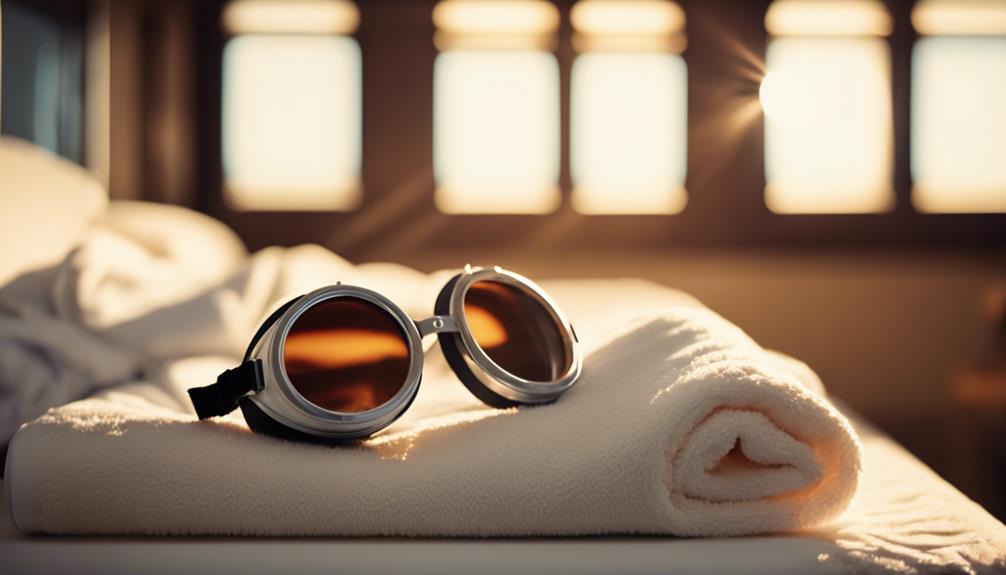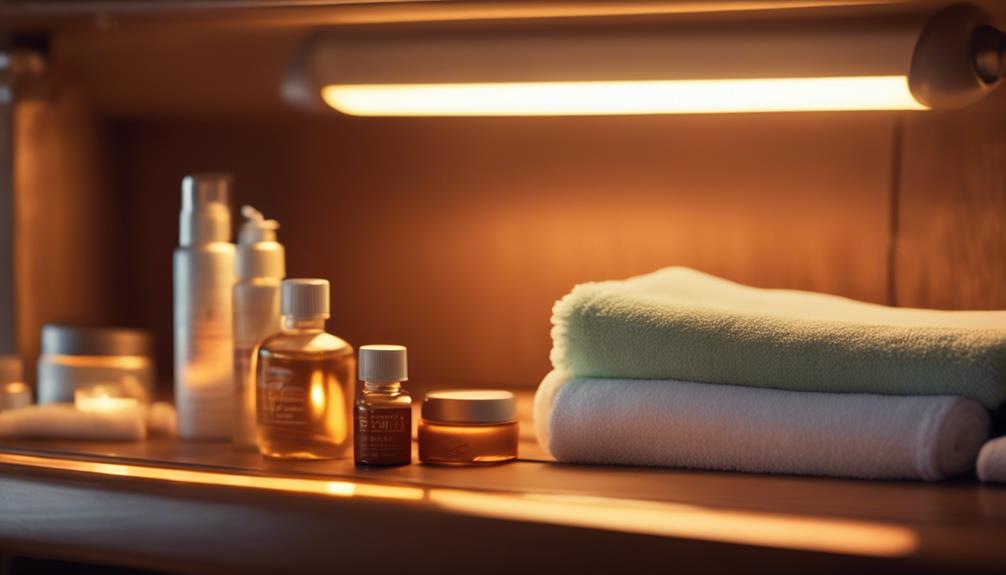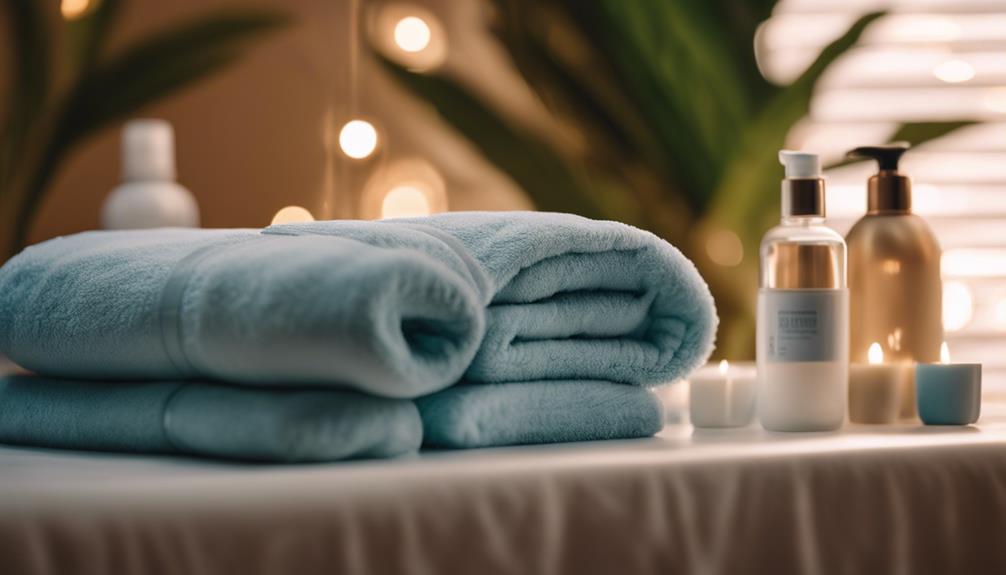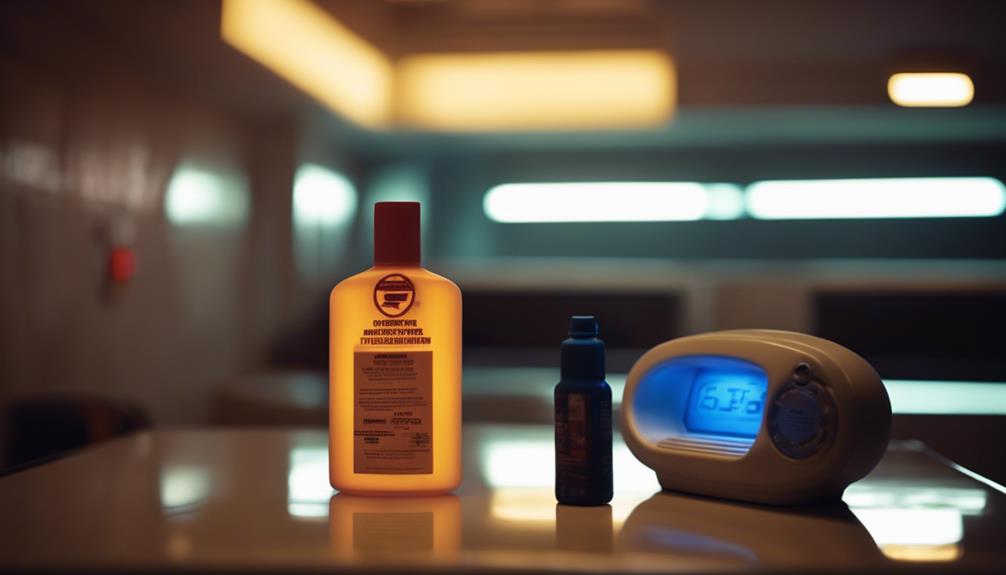To perfect your tanning bed routine today, begin by assessing your skin type in order to customize your approach. Exfoliate 24 hours in advance for a more even tan and remember to always moisturize. Start with short sessions lasting 5-7 minutes, gradually increasing time each week. Keep your tanning sessions to 2-4 times a week and consistently wear 100% UV protective goggles to protect your eyes. Utilize specialized indoor tanning lotions to boost your results, and consider using tan extenders to preserve your color. By following these suggestions, you will establish a strong foundation, with additional tips available to further optimize your tanning experience.
Key Takeaways
- Assess your skin type and consult professionals for a personalized tanning schedule and UV exposure plan.
- Exfoliate 24 hours before tanning and moisturize regularly to achieve even and long-lasting results.
- Start with shorter tanning sessions, gradually increasing duration while monitoring skin reaction for optimal safety.
- Always wear 100% UV-protective goggles during sessions to prevent eye damage and ensure safety.
Skin Assessment and Preparation
Before you begin your tanning journey, it's crucial to assess your skin type to guarantee a safe and effective tanning experience.
Identify whether your skin is sensitive, normal, or resilient, as this will help tailor your tanning approach. Consulting with a tanning professional can establish a schedule that matches your skin's reaction to UV exposure.
Exfoliate your skin 24 hours before tanning to remove dead cells for a more even tan. Don't forget to moisturize, as this enhances tanning results and keeps your skin hydrated.
Avoid lotions with oils or fragrances before tanning, and always conduct a patch test for new products.
Tanning Session Strategy
To achieve the best results, start with shorter tanning sessions and gradually increase the exposure time as your skin adjusts. It's crucial to keep a structured tanning schedule, allowing your skin to recover adequately between sessions. Limit your tanning to 2-4 times per week, depending on how your skin reacts. Here's a simple session strategy to follow:
| Week | Session Duration |
|---|---|
| 1 | 5-7 minutes |
| 2 | 8-10 minutes |
| 3 | 11-15 minutes |
| 4 | 16-20 minutes |
Remember to maintain a minimum of 48 hours between sessions and always consult with professionals if you're unsure about adjusting your schedule. This way, you'll achieve a beautiful tan while minimizing damage.
Eye Protection and Safety

Protecting your eyes during tanning sessions is vital to avoid UV damage and guarantee a safe experience. Always wear tanning bed goggles that offer 100% UV protection.
These specialized goggles fit snugly, preventing light leakage, unlike regular sunglasses that may not shield your eyes effectively. If your goggles show signs of wear or damage, replace them immediately to make sure your eyes remain protected.
Remember, unprotected exposure can lead to long-term vision problems, so never skip this vital step. Additionally, consult tanning professionals to tailor your tanning schedule based on your skin type and needs.
Prioritizing eye safety not only enhances your tanning experience but also safeguards your health, making certain you achieve that perfect glow without compromising your vision.
Maintenance of Tanning Equipment
Regular maintenance of tanning equipment is vital for guaranteeing safety and ideal performance during your tanning sessions.
Start by cleaning the tanning bed after each use with approved disinfectants to prevent bacteria buildup and skin irritation.
It's important to replace the bulbs every 1-2 years to maintain peak light output, and don't forget to check and clean the filters monthly for proper airflow.
Additionally, consider scheduling professional maintenance annually to extend the longevity of your tanning equipment.
Keeping everything in top shape not only enhances your tanning experience but also guarantees you're using safe, effective equipment.
Effective Product Usage

Using the right products can greatly enhance your tanning results and prolong the life of your tan. To maximize your tanning experience, consider incorporating these essential products into your routine:
- Indoor tanning lotions: These specially formulated lotions hydrate your skin and boost the tanning process, giving you a deeper, more even tan.
- Tan extenders: Use these after your tanning sessions to maintain your color and keep your skin moisturized.
Frequently Asked Questions
How Can I Determine My Skin Type Accurately?
To determine your skin type accurately, observe how your skin reacts to products and environmental factors. Notice if it's oily, dry, sensitive, or normal, and consult a dermatologist for a professional assessment if needed.
What Should I Do if I Get a Sunburn From Tanning?
Think of your skin as a delicate canvas. If you get a sunburn from tanning, cool it down with aloe vera, hydrate, and let it heal. Avoid further tanning until fully recovered to prevent damage.
Are There Specific Foods That Enhance Tanning Results?
Certain foods can enhance tanning results. Incorporate carrots, tomatoes, and leafy greens into your diet. These foods contain beta-carotene and antioxidants that promote skin health and can help you achieve a richer, more even tan.
Can I Tan if I Have Acne or Skin Conditions?
You can tan with acne or skin conditions, but it's essential to consult a dermatologist first. They'll help you determine if tanning is safe for your skin and suggest appropriate precautions to minimize irritation.
How Does Tanning Affect My Overall Skin Health Long-Term?
Did you know that over 90% of skin aging is caused by UV exposure? Long-term tanning can lead to premature aging, increased risk of skin cancer, and uneven skin tone, so consider moderation and protection for healthier skin.
What are the best practices for tanning bed aftercare to maximize the results of my tanning bed routine?
After a tanning bed session, it’s crucial to follow proper tanning bed aftercare tips to maintain your tan and keep your skin healthy. Moisturize daily to prevent dryness and peeling, drink plenty of water, and exfoliate regularly to remove dead skin cells. These practices will maximize the results of your tanning bed routine.
Are the Tanning Bed Techniques Mentioned in Topic 2 Suitable for Regular Tanning Bed Routine?
The safe tanning bed techniques mentioned in Topic 2 are suitable for a regular tanning bed routine. Following these techniques, such as setting a time limit, using protective eyewear, and moisturizing the skin, can help minimize the potential risks of tanning bed exposure while still achieving a desired bronzed glow.
Conclusion
By mastering your tanning bed routine, you're not just aiming for a beautiful glow; you're also prioritizing your skin's health.
Did you know that 90% of skin aging is caused by sun exposure? Taking the time to assess your skin, use proper protection, and maintain your tanning equipment can greatly reduce your risk of damage while helping you achieve that sun-kissed look.
Embrace these steps, and you'll shine with confidence and radiance!










